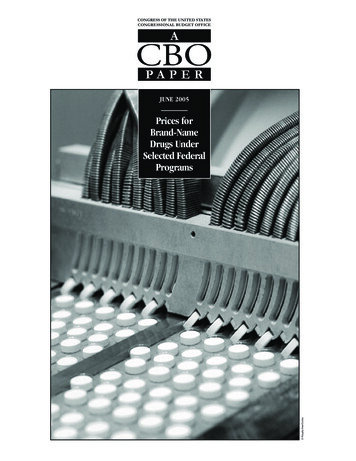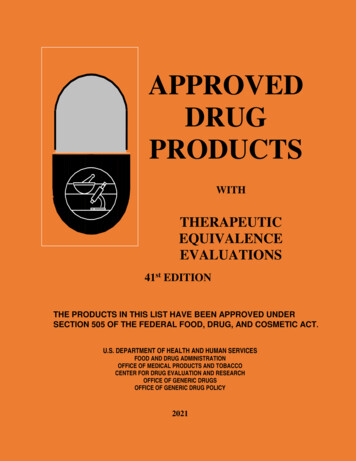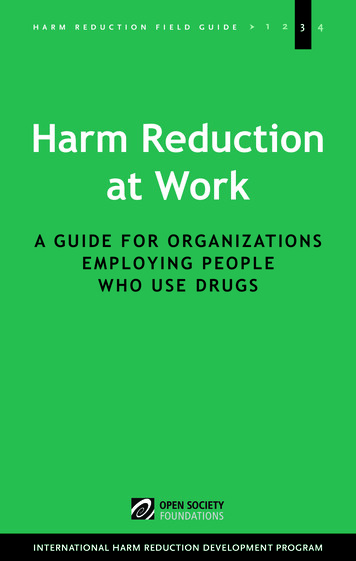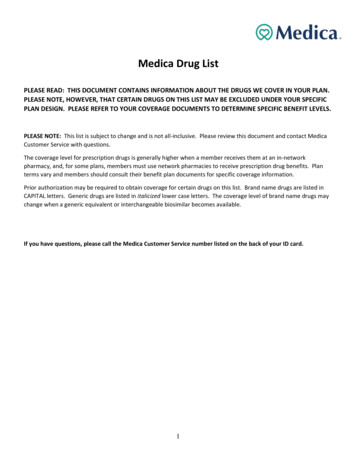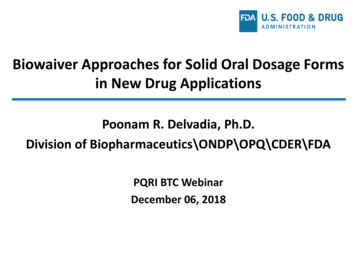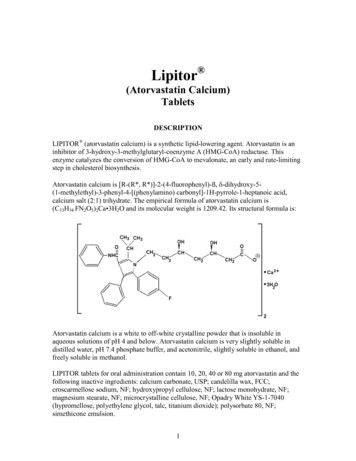
Transcription
Lipitor (Atorvastatin Calcium)TabletsDESCRIPTIONLIPITOR (atorvastatin calcium) is a synthetic lipid-lowering agent. Atorvastatin is aninhibitor of 3-hydroxy-3-methylglutaryl-coenzyme A (HMG-CoA) reductase. Thisenzyme catalyzes the conversion of HMG-CoA to mevalonate, an early and rate-limitingstep in cholesterol biosynthesis.Atorvastatin calcium is [R-(R*, R*)]-2-(4-fluorophenyl)-ß, no) carbonyl]-1H-pyrrole-1-heptanoic acid,calcium salt (2:1) trihydrate. The empirical formula of atorvastatin calcium is(C33H34 FN2O5)2Ca 3H2O and its molecular weight is 1209.42. Its structural formula is:Atorvastatin calcium is a white to off-white crystalline powder that is insoluble inaqueous solutions of pH 4 and below. Atorvastatin calcium is very slightly soluble indistilled water, pH 7.4 phosphate buffer, and acetonitrile, slightly soluble in ethanol, andfreely soluble in methanol.LIPITOR tablets for oral administration contain 10, 20, 40 or 80 mg atorvastatin and thefollowing inactive ingredients: calcium carbonate, USP; candelilla wax, FCC;croscarmellose sodium, NF; hydroxypropyl cellulose, NF; lactose monohydrate, NF;magnesium stearate, NF; microcrystalline cellulose, NF; Opadry White YS-1-7040(hypromellose, polyethylene glycol, talc, titanium dioxide); polysorbate 80, NF;simethicone emulsion.1
CLINICAL PHARMACOLOGYMechanism of ActionAtorvastatin is a selective, competitive inhibitor of HMG-CoA reductase, the ratelimiting enzyme that converts 3-hydroxy-3-methylglutaryl-coenzyme A to mevalonate, aprecursor of sterols, including cholesterol. Cholesterol and triglycerides circulate in thebloodstream as part of lipoprotein complexes. With ultracentrifugation, these complexesseparate into HDL (high-density lipoprotein), IDL (intermediate-density lipoprotein),LDL (low-density lipoprotein), and VLDL (very-low-density lipoprotein) fractions.Triglycerides (TG) and cholesterol in the liver are incorporated into VLDL and releasedinto the plasma for delivery to peripheral tissues. LDL is formed from VLDL and iscatabolized primarily through the high-affinity LDL receptor. Clinical and pathologicstudies show that elevated plasma levels of total cholesterol (total-C), LDL-cholesterol(LDL-C), and apolipoprotein B (apo B) promote human atherosclerosis and are riskfactors for developing cardiovascular disease, while increased levels of HDL-C areassociated with a decreased cardiovascular risk.In animal models, LIPITOR lowers plasma cholesterol and lipoprotein levels byinhibiting HMG-CoA reductase and cholesterol synthesis in the liver and by increasingthe number of hepatic LDL receptors on the cell-surface to enhance uptake andcatabolism of LDL; LIPITOR also reduces LDL production and the number of LDLparticles. LIPITOR reduces LDL-C in some patients with homozygous familialhypercholesterolemia (FH), a population that rarely responds to other lipid-loweringmedication(s).A variety of clinical studies have demonstrated that elevated levels of total-C, LDL-C,and apo B (a membrane complex for LDL-C) promote human atherosclerosis. Similarly,decreased levels of HDL-C (and its transport complex, apo A) are associated with thedevelopment of atherosclerosis. Epidemiologic investigations have established thatcardiovascular morbidity and mortality vary directly with the level of total-C and LDL-C,and inversely with the level of HDL-C.LIPITOR reduces total-C, LDL-C, and apo B in patients with homozygous andheterozygous FH, nonfamilial forms of hypercholesterolemia, and mixed dyslipidemia.LIPITOR also reduces VLDL-C and TG and produces variable increases in HDL-C andapolipoprotein A-1. LIPITOR reduces total-C, LDL-C, VLDL-C, apo B, TG, and nonHDL-C, and increases HDL-C in patients with isolated hypertriglyceridemia. LIPITORreduces intermediate density lipoprotein cholesterol (IDL-C) in patients withdysbetalipoproteinemia.Like LDL, cholesterol-enriched triglyceride-rich lipoproteins, including VLDL,intermediate density lipoprotein (IDL), and remnants, can also promote atherosclerosis.Elevated plasma triglycerides are frequently found in a triad with low HDL-C levels andsmall LDL particles, as well as in association with non-lipid metabolic risk factors for2
coronary heart disease. As such, total plasma TG has not consistently been shown to bean independent risk factor for CHD. Furthermore, the independent effect of raising HDLor lowering TG on the risk of coronary and cardiovascular morbidity and mortality hasnot been determined.PharmacodynamicsAtorvastatin as well as some of its metabolites are pharmacologically active in humans.The liver is the primary site of action and the principal site of cholesterol synthesis andLDL clearance. Drug dosage rather than systemic drug concentration correlates betterwith LDL-C reduction. Individualization of drug dosage should be based on therapeuticresponse (see DOSAGE AND ADMINISTRATION).Pharmacokinetics and Drug MetabolismAbsorption: Atorvastatin is rapidly absorbed after oral administration; maximum plasmaconcentrations occur within 1 to 2 hours. Extent of absorption increases in proportion toatorvastatin dose. The absolute bioavailability of atorvastatin (parent drug) isapproximately 14% and the systemic availability of HMG-CoA reductase inhibitoryactivity is approximately 30%. The low systemic availability is attributed to presystemicclearance in gastrointestinal mucosa and/or hepatic first-pass metabolism. Although fooddecreases the rate and extent of drug absorption by approximately 25% and 9%,respectively, as assessed by Cmax and AUC, LDL-C reduction is similar whetheratorvastatin is given with or without food. Plasma atorvastatin concentrations are lower(approximately 30% for Cmax and AUC) following evening drug administrationcompared with morning. However, LDL-C reduction is the same regardless of the time ofday of drug administration (see DOSAGE AND ADMINISTRATION).Distribution: Mean volume of distribution of atorvastatin is approximately 381 liters.Atorvastatin is 98% bound to plasma proteins. A blood/plasma ratio of approximately0.25 indicates poor drug penetration into red blood cells. Based on observations in rats,atorvastatin is likely to be secreted in human milk (see CONTRAINDICATIONS,Pregnancy and Lactation, and PRECAUTIONS, Nursing Mothers).Metabolism: Atorvastatin is extensively metabolized to ortho- and parahydroxylatedderivatives and various beta-oxidation products. In vitro inhibition of HMG-CoAreductase by ortho- and parahydroxylated metabolites is equivalent to that of atorvastatin.Approximately 70% of circulating inhibitory activity for HMG-CoA reductase isattributed to active metabolites. In vitro studies suggest the importance of atorvastatinmetabolism by cytochrome P450 3A4, consistent with increased plasma concentrations ofatorvastatin in humans following coadministration with erythromycin, a known inhibitorof this isozyme (see PRECAUTIONS, Drug Interactions). In animals, the ortho-hydroxymetabolite undergoes further glucuronidation.Excretion: Atorvastatin and its metabolites are eliminated primarily in bile followinghepatic and/or extra-hepatic metabolism; however, the drug does not appear to undergo3
enterohepatic recirculation. Mean plasma elimination half-life of atorvastatin in humansis approximately 14 hours, but the half-life of inhibitory activity for HMG-CoA reductaseis 20 to 30 hours due to the contribution of active metabolites. Less than 2% of a dose ofatorvastatin is recovered in urine following oral administration.Special PopulationsGeriatric: Plasma concentrations of atorvastatin are higher (approximately 40% forCmax and 30% for AUC) in healthy elderly subjects (age 65 years) than in youngadults. Clinical data suggest a greater degree of LDL-lowering at any dose of drug in theelderly patient population compared to younger adults (see PRECAUTIONS section;Geriatric Use subsection).Pediatric: Pharmacokinetic data in the pediatric population are not available.Gender: Plasma concentrations of atorvastatin in women differ from those in men(approximately 20% higher for Cmax and 10% lower for AUC); however, there is noclinically significant difference in LDL-C reduction with LIPITOR between men andwomen.Renal Insufficiency: Renal disease has no influence on the plasma concentrations orLDL-C reduction of atorvastatin; thus, dose adjustment in patients with renal dysfunctionis not necessary (see DOSAGE AND ADMINISTRATION).Hemodialysis: While studies have not been conducted in patients with end-stage renaldisease, hemodialysis is not expected to significantly enhance clearance of atorvastatinsince the drug is extensively bound to plasma proteins.Hepatic Insufficiency: In patients with chronic alcoholic liver disease, plasmaconcentrations of atorvastatin are markedly increased. Cmax and AUC are each 4-foldgreater in patients with Childs-Pugh A disease. Cmax and AUC are approximately 16fold and 11-fold increased, respectively, in patients with Childs-Pugh B disease (seeCONTRAINDICATIONS).Clinical StudiesPrevention of Cardiovascular DiseaseIn the Anglo-Scandinavian Cardiac Outcomes Trial (ASCOT), the effect of LIPITOR(atorvastatin calcium) on fatal and non-fatal coronary heart disease was assessed in10,305 hypertensive patients 40-80 years of age (mean of 63 years), without a previousmyocardial infarction and with TC levels 251 mg/dl (6.5 mmol/l). Additionally allpatients had at least 3 of the following cardiovascular risk factors: male gender (81.1%),age 55 years (84.5%), smoking (33.2%), diabetes (24.3%), history of CHD in a firstdegree relative (26%), TC:HDL 6 (14.3%), peripheral vascular disease (5.1%), leftventricular hypertrophy (14.4%), prior cerebrovascular event (9.8%), specific ECG4
abnormality (14.3%), proteinuria/albuminuria (62.4%). In this double-blind, placebocontrolled study patients were treated with anti-hypertensive therapy (Goal BP 140/90mm Hg for non-diabetic patients, 130/80 mm Hg for diabetic patients) and allocated toeither LIPITOR 10 mg daily (n 5168) or placebo (n 5137), using a covariate adaptivemethod which took into account the distribution of nine baseline characteristics ofpatients already enrolled and minimized the imbalance of those characteristics across thegroups. Patients were followed for a median duration of 3.3 years.The effect of 10 mg/day of LIPITOR on lipid levels was similar to that seen in previousclinical trials.LIPITOR significantly reduced the rate of coronary events [either fatal coronary heartdisease (46 events in the placebo group vs. 40 events in the LIPITOR group) or nonfatalMI (108 events in the placebo group vs. 60 events in the LIPITOR group)] with arelative risk reduction of 36% [(based on incidences of 1.9% for LIPITOR vs. 3.0% forplacebo), p 0.0005 (see Figure 1)]. The risk reduction was consistent regardless of age,smoking status, obesity or presence of renal dysfunction. The effect of LIPITOR wasseen regardless of baseline LDL levels. Due to the small number of events, results forwomen were inconclusive.Figure 1: Effect of LIPITOR 10 mg/day on Cumulative Incidence of NonfatalMyocardial Infarction or Coronary Heart Disease Death (in ASCOT-LLA)LIPITOR also significantly decreased the relative risk for revascularization procedures by42%. Although the reduction of fatal and non-fatal strokes did not reach a pre-definedsignificance level (p 0.01), a favorable trend was observed with a 26% relative riskreduction (incidences of 1.7% for LIPITOR and 2.3% for placebo). There was nosignificant difference between the treatment groups for death due to cardiovascularcauses (p 0.51) or noncardiovascular causes (p 0.17).In the Collaborative Atorvastatin Diabetes Study (CARDS), the effect of LIPITOR(atorvastatin calcium) on cardiovascular disease (CVD) endpoints was assessed in 28385
subjects (94% White, 68% male), ages 40-75 with type 2 diabetes based on WHOcriteria, without prior history of cardiovascular disease and with LDL 160 mg/dL andTG 600 mg/dL. In addition to diabetes, subjects had 1 or more of the following riskfactors: current smoking (23%), hypertension (80%), retinopathy (30%), ormicroalbuminuria (9%) or macroalbuminuria (3%). No subjects on hemodialysis wereenrolled in the study. In this multicenter, placebo-controlled, double-blind clinical trial,subjects were randomly allocated to either LIPITOR 10 mg daily (1429) or placebo(1411) in a 1:1 ratio and were followed for a median duration of 3.9 years. The primaryendpoint was the occurrence of any of the major cardiovascular events: myocardialinfarction, acute CHD death, unstable angina, coronary revascularization, or stroke. Theprimary analysis was the time to first occurrence of the primary endpoint.Baseline characteristics of subjects were: mean age of 62 years, mean HbA1c 7.7%;median LDL-C 120 mg/dL; median TC 207 mg/dL; median TG 151 mg/dL; medianHDL-C 52mg/dL.The effect of LIPITOR 10 mg/ day on lipid levels was similar to that seen in previousclinical trials.LIPITOR significantly reduced the rate of major cardiovascular events (primary endpointevents) (83 events in the LIPITOR group vs. 127 events in the placebo group) with arelative risk reduction of 37%, HR 0.63, 95% CI (0.48,0.83) (p 0.001) (see Figure 2).An effect of LIPITOR was seen regardless of age, sex, or baseline lipid levels.6
Figure 2. Effect of LIPITOR 10 mg/day on Time to Occurrence of MajorCardiovascular Event (myocardial infarction, acute CHD death,unstable angina, coronary revascularization, or stroke) in CARDS.LIPITOR significantly reduced the risk of stroke by 48% (21 events in the LIPITORgroup vs 39 events in the placebo group), HR 0.52, 95% CI (0.31,0.89) (p 0.016) andreduced the risk of MI by 42% (38 events in the LIPITOR group vs 64 events in theplacebo group), HR 0.58, 95.1% CI (0.39, 0.86) (p 0.007). There was no significantdifference between the treatment groups for angina, revascularization procedures, andacute CHD death.There were 61 deaths in the LIPITOR group vs 82 deaths in the placebo group, (HR 0.73,p 0.059).In the Treating to New Targets Study (TNT), the effect of LIPITOR 80 mg/day vs.LIPITOR 10 mg/day on the reduction in cardiovascular events was assessed in 10,001subjects (94% white, 81% male, 38% 65 years) with clinically evident coronary heartdisease who had achieved a target LDL-C level 130 mg/dL after completing an 8-week,open-label, run-in period with LIPITOR 10 mg/day. Subjects were randomly assigned toeither 10 mg/day or 80 mg/day of LIPITOR and followed for a median duration of 4.9years. The primary endpoint was the time-to-first occurrence of any of the followingmajor cardiovascular events (MCVE): death due to CHD, non-fatal myocardialinfarction, resuscitated cardiac arrest, and fatal and non-fatal stroke. The mean LDL-C,7
TC, TG, non-HDL and HDL cholesterol levels at 12 weeks were 73, 145, 128, 98 and 47mg/dL during treatment with 80 mg of LIPITOR and 99, 177, 152, 129 and 48 mg/dLduring treatment with 10 mg of LIPITOR.Treatment with LIPITOR 80 mg/day significantly reduced the rate of MCVE (434 eventsin the 80mg/day group vs 548 events in the 10 mg/day group) with a relative riskreduction of 22%, HR 0.78, 95% CI (0.69,0.89), p 0.0002 (see Figure 3 and Table 1).The overall risk reduction was consistent regardless of age ( 65, 65) or gender.Figure 3. Effect of LIPITOR 80 mg/day vs.10 mg/day on Time to Occurrence ofMajor Cardiovascular Events (TNT)8
TABLE 1. Overview of Efficacy Results in TNTEndpointPRIMARY ENDPOINTFirst major cardiovascular endpointComponents of the Primary EndpointCHD deathNonfatal, non-procedure related MIResuscitated cardiac arrestStroke (fatal and non-fatal)SECONDARY ENDPOINTS*First CHF with hospitalizationFirst PVD endpointFirst CABG or other coronaryrevascularization procedurebFirst documented angina endpointbAll cause mortalityComponents of all cause mortalityCardiovascular deathNoncardiovascular deathCancer deathOther non-CV deathSuicide, homicide and othertraumatic non-CV deathAtorvastatin 10mg(N 5006)n(%)548(10.9)Atorvastatin 80mg(N 4995)n(%)434(8.7)HRa (95%CI)0.78 (0.69, 0)(4.9)(0.5)(2.3)0.80 (0.61, 1.03)0.78 (0.66, 0.93)0.96 (0.56, 1.67)0.75 (0.59, 13.4)0.74 (0.59, 0.94)0.97 (0.83, 1.15)0.72 (0.65, 0.80)615282(12.3)(5.6)545284(10.9)(5.7)0.88 (0.79, 0.99)1.01 (0.85, 815(2.5)(3.2)(1.7)(1.2)(0.3)0.81 (0.64, 1.03)1.25 (0.99, 1.57)1.13 (0.83, 1.55)1.35 (0.91, 2.00)1.67 (0.73, 3.82)a Atorvastatin 80 mg: atorvastatin 10 mgb component of other secondary endpoints* secondary endpoints not included in primary endpointHR hazard ratio; CHD coronary heart disease; CI confidence interval; MI myocardial infarction; CHF congestive heart failure;CV cardiovascular; PVD peripheral vascular disease; CABG coronary artery bypass graftConfidence intervals for the Secondary Endpoints were not adjusted for multiple comparisonsOf the events that comprised the primary efficacy endpoint, treatment with LIPITOR 80mg/day significantly reduced the rate of nonfatal, non-procedure related MI and fatal andnon-fatal stroke, but not CHD death or resuscitated cardiac arrest (Table 1). Of thepredefined secondary endpoints, treatment with LIPITOR 80 mg/day significantlyreduced the rate of coronary revascularization, angina and hospitalization for heartfailure, but not peripheral vascular disease. The reduction in the rate of CHF withhospitalization was only observed in the 8% of patients with a prior history of CHF.There was no significant difference between the treatment groups for all-cause mortality(Table 1). The proportions of subjects who experienced cardiovascular death, includingthe components of CHD death and fatal stroke were numerically smaller in the LIPITOR80 mg group than in the LIPITOR 10 mg treatment group. The proportions of subjectswho experienced noncardiovascular death were numerically larger in the LIPITOR 80 mggroup than in the LIPITOR 10 mg treatment group.In the Incremental Decrease in Endpoints Through Aggressive Lipid Lowering Study(IDEAL), treatment with LIPITOR 80 mg/day was compared to treatment withsimvastatin 20-40 mg/day in 8,888 subjects up to 80 years of age with a history of CHD9
to assess whether reduction in CV risk could be achieved. Patients were mainly male(81%), white (99%) with an average age of 61.7 years, and an averageLDL-C of 121.5 mg/dL at randomization; 76% were on statin therapy. In thisprospective, randomized, open-label, blinded endpoint (PROBE) trial with no run-inperiod, subjects were followed for a median duration of 4.8 years. The mean LDL-C, TC,TG, HDL and non-HDL cholesterol levels at Week 12 were 78, 145, 115, 45 and 100mg/dL during treatment with 80 mg of LIPITOR and 105, 179, 142, 47 and 132 mg/dLduring treatment with 20-40 mg of simvastatin.There was no significant difference between the treatment groups for the primaryendpoint, the rate of first major coronary event (fatal CHD, nonfatal MI and resuscitatedcardiac arrest): 411 (9.3%) in the LIPITOR 80 mg/day group vs. 463 (10.4%) in thesimvastatin 20-40 mg/day group, HR 0.89, 95% CI ( 0.78,1.01), p 0.07.There were no significant differences between the treatment groups for all-causemortality: 366 (8.2%) in the LIPITOR 80 mg/day group vs. 374 (8.4%) in the simvastatin20-40 mg/day group. The proportions of subjects who experienced CV or non-CV deathwere similar for the LIPITOR 80 mg group and the simvastatin 20-40 mg group.Hypercholesterolemia (Heterozygous Familial and Nonfamilial) and MixedDyslipidemia (Fredrickson Types IIa and IIb)LIPITOR reduces total-C, LDL-C, VLDL-C, apo B, and TG, and increases HDL-C inpatients with hypercholesterolemia and mixed dyslipidemia. Therapeutic response is seenwithin 2 weeks, and maximum response is usually achieved within 4 weeks andmaintained during chronic therapy.LIPITOR is effective in a wide variety of patient populations with hypercholesterolemia,with and without hypertriglyceridemia, in men and women, and in the elderly.Experience in pediatric patients has been limited to patients with homozygous FH.In two multicenter, placebo-controlled, dose-response studies in patients withhypercholesterolemia, LIPITOR given as a single dose over 6 weeks significantlyreduced total-C, LDL-C, apo B, and TG (Pooled results are provided in Table 2).TABLE 2. Dose-Response in Patients With Primary Hypercholesterolemia(Adjusted Mean % Change From -37-45LDL-C4-39-43-50-60Results are pooled from 2 dose-response studies.10Apo -369657-34-41-45-53
In patients with Fredrickson Types IIa and IIb hyperlipoproteinemia pooled from 24controlled trials, the median (25th and 75th percentile) percent changes from baseline inHDL-C for atorvastatin 10, 20, 40, and 80 mg were 6.4 (-1.4, 14), 8.7(0, 17), 7.8(0, 16),and 5.1 (-2.7, 15), respectively. Additionally, analysis of the pooled data demonstratedconsistent and significant decreases in total-C, LDL-C, TG, total-C/HDL-C, and LDLC/HDL-C.In three multicenter, double-blind studies in patients with hypercholesterolemia,LIPITOR was compared to other HMG-CoA reductase inhibitors. After randomization,patients were treated for 16 weeks with either LIPITOR 10 mg per day or a fixed dose ofthe comparative agent (Table 3).TABLE 3. Mean Percent Change From Baseline at Endpoint(Double-Blind, Randomized, Active-Controlled Trials)Treatment(Daily Dose)Study 1Atorvastatin 10 mgLovastatin 20 mg95% CI for Diff1Study 2Atorvastatin 10 mgPravastatin 20 mg95% CI for Diff1Study 3Atorvastatin 10 mgSimvastatin 10 mg95% CI for Diff1NTotal-CLDL-CApo BTGHDL-CNon-HDL-C/HDL-C707191-27a-19-9.2, -6.5-36a-27-10.7, -7.1-28a-20-10.0, -6.5-17a-6-15.2, -7.1 7 7-1.7, 2.0-37a-28-11.1, -7.122277-25b-17-10.8, -6.1-35b-23-14.5, -8.2-27b-17-13.4, -7.4-17b-9-14.1, -0.7 6 8-4.9, 1.6-36b-28-11.5, -4.113245-29c-24-8.7, -2.7-37c-30-10.1, -2.6-34c-30-8.0, -1.1-23c-15-15.1, -0.7 7 7-4.3, 3.9-39c-33-9.6, -1.91A negative value for the 95% CI for the difference between treatments favors atorvastatin for all exceptHDL-C, for which a positive value favors atorvastatin. If the range does not include 0, this indicates astatistically significant difference.aSignificantly different from lovastatin, ANCOVA, p 0.05bSignificantly different from pravastatin, ANCOVA, p 0.05cSignificantly different from simvastatin, ANCOVA, p 0.05The impact on clinical outcomes of the differences in lipid-altering effects betweentreatments shown in Table 3 is not known. Table 3 does not contain data comparing theeffects of atorvastatin 10 mg and higher doses of lovastatin, pravastatin, and simvastatin.The drugs compared in the studies summarized in the table are not necessarilyinterchangeable.Hypertriglyceridemia (Fredrickson Type IV)The response to LIPITOR in 64 patients with isolated hypertriglyceridemia treated acrossseveral clinical trials is shown in the table below. For the atorvastatin-treated patients,median (min, max) baseline TG level was 565 (267-1502).11
TABLE 4. Combined Patients With Isolated Elevated TG:Median (min, max) Percent Changes From L-CPlacebo(N 12)-12.4 (-36.6, 82.7)-2.3 (-15.5, 24.4)3.6 (-31.3, 31.6)3.8 (-18.6, 13.4)-1.0 (-31.9, 53.2)-2.8 (-17.6, 30.0)Atorvastatin 10 mg(N 37)-41.0 (-76.2, 49.4)-28.2 (-44.9, -6.8)-26.5 (-57.7, 9.8)13.8 (-9.7, 61.5)-48.8 (-85.8, 57.3)-33.0 (-52.1, -13.3)Atorvastatin 20 mg(N 13)-38.7 (-62.7, 29.5)-34.9 (-49.6, -15.2)-30.4 (-53.9, 0.3)11.0 (-3.2, 25.2)-44.6 (-62.2, -10.8)-42.7 (-53.7, -17.4)Atorvastatin 80 mg(N 14)-51.8 (-82.8, 41.3)-44.4 (-63.5, -3.8)-40.5 (-60.6, -13.8)7.5 (-10.8, 37.2)-62.0 (-88.2, 37.6)-51.5 (-72.9, -4.3)Dysbetalipoproteinemia (Fredrickson Type III)The results of an open-label crossover study of 16 patients (genotypes: 14 apo E2/E2 and2 apo E3/E2) with dysbetalipoproteinemia (Fredrickson Type III) are shown in the tablebelow.TABLE 5. Open-Label Crossover Study of 16 PatientsWith Dysbetalipoproteinemia (Fredrickson Type III)Total-CTriglyceridesIDL-C VLDL-Cnon-HDL-CMedian (min, max) atBaseline (mg/dL)442 (225, 1320)678 (273, 5990)215 (111, 613)411 (218, 1272)Median % Change (min, max)Atorvastatin 10 mgAtorvastatin 80 mg-37 (-85, 17)-39 (-92, -8)-32 (-76, 9)-43 (-87, -19)-58 (-90, -31)-53 (-95, -30)-63 (-90, -8)-64 (-92, -36)Homozygous Familial HypercholesterolemiaIn a study without a concurrent control group, 29 patients ages 6 to 37 years withhomozygous FH received maximum daily doses of 20 to 80 mg of LIPITOR. The meanLDL-C reduction in this study was 18%. Twenty-five patients with a reduction in LDL-Chad a mean response of 20% (range of 7% to 53%, median of 24%); the remaining 4patients had 7% to 24% increases in LDL-C. Five of the 29 patients had absent LDLreceptor function. Of these, 2 patients also had a portacaval shunt and had no significantreduction in LDL-C. The remaining 3 receptor-negative patients had a mean LDL-Creduction of 22%.Heterozygous Familial Hypercholesterolemia in Pediatric PatientsIn a double-blind, placebo-controlled study followed by an open-label phase, 187 boysand postmenarchal girls 10-17 years of age (mean age 14.1 years) with heterozygousfamilial hypercholesterolemia (FH) or severe hypercholesterolemia were randomized toLIPITOR (n 140) or placebo (n 47) for 26 weeks and then all received LIPITOR for 26weeks. Inclusion in the study required 1) a baseline LDL-C level 190 mg/dL or 2) a12
baseline LDL-C 160 mg/dL and positive family history of FH or documentedpremature cardiovascular disease in a first- or second-degree relative. The mean baselineLDL-C value was 218.6 mg/dL (range: 138.5-385.0 mg/dL) in the LIPITOR groupcompared to 230.0 mg/dL (range: 160.0-324.5 mg/dL) in the placebo group. The dosageof LIPITOR (once daily) was 10 mg for the first 4 weeks and up-titrated to 20 mg if theLDL-C level was 130 mg/dL. The number of LIPITOR-treated patients who requiredup-titration to 20 mg after Week 4 during the double-blind phase was 80 (57.1%).LIPITOR significantly decreased plasma levels of total-C, LDL-C, triglycerides, andapolipoprotein B during the 26 week double-blind phase (see Table 6).TABLE 6Lipid-altering Effects of LIPITOR in Adolescent Boys and Girls with Heterozygous FamilialHypercholesterolemia or Severe Hypercholesterolemia(Mean Percent Change from Baseline at Endpoint in Intention-to-Treat n 8-12.0-34.0The mean achieved LDL-C value was 130.7 mg/dL (range: 70.0-242.0 mg/dL) in theLIPITOR group compared to 228.5 mg/dL (range: 152.0-385.0 mg/dL) in the placebogroup during the 26 week double-blind phase.The safety and efficacy of doses above 20 mg have not been studied in controlled trials inchildren. The long-term efficacy of LIPITOR therapy in childhood to reduce morbidityand mortality in adulthood has not been established.INDICATIONS AND USAGEPrevention of Cardiovascular DiseaseIn adult patients without clinically evident coronary heart disease, but with multiple riskfactors for coronary heart disease such as age, smoking, hypertension, low HDL-C, or afamily history of early coronary heart disease, LIPITOR is indicated to: Reduce the risk of myocardial infarction Reduce the risk of stroke Reduce the risk for revascularization procedures and anginaIn patients with type 2 diabetes, and without clinically evident coronary heart disease, butwith multiple risk factors for coronary heart disease such as retinopathy, albuminuria,smoking, or hypertension, LIPITOR is indicated to: Reduce the risk of myocardial infarction Reduce the risk of strokeIn patients with clinically evident coronary heart disease
(C 33 H 34 FN 2 O 5) 2 Ca 3H 2 O and its molecular weight is 1209.42. Its structural formula is: . The absolute bioavailability of atorvastatin (parent drug) is approximately 14% and the systemic availability of HMG-CoA reductase inhibitory activity is approximately 30%. The low systemic availability is attributed to presystemic
